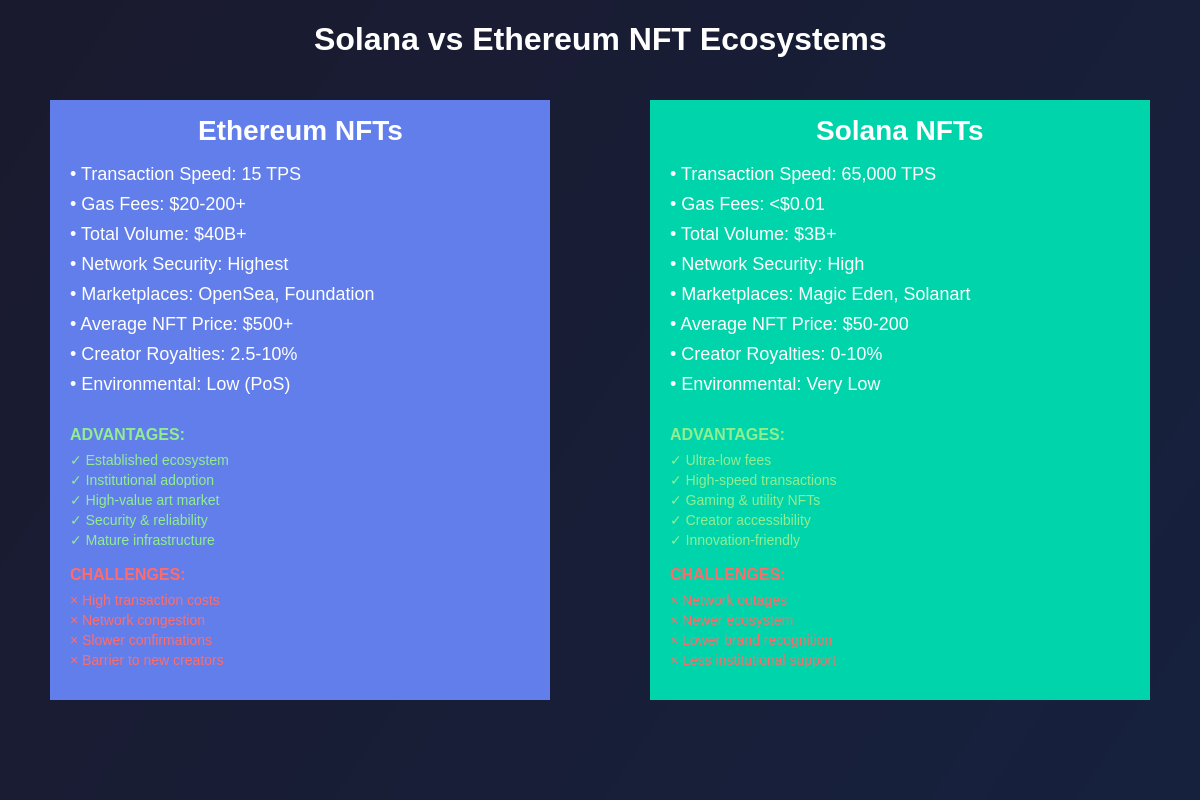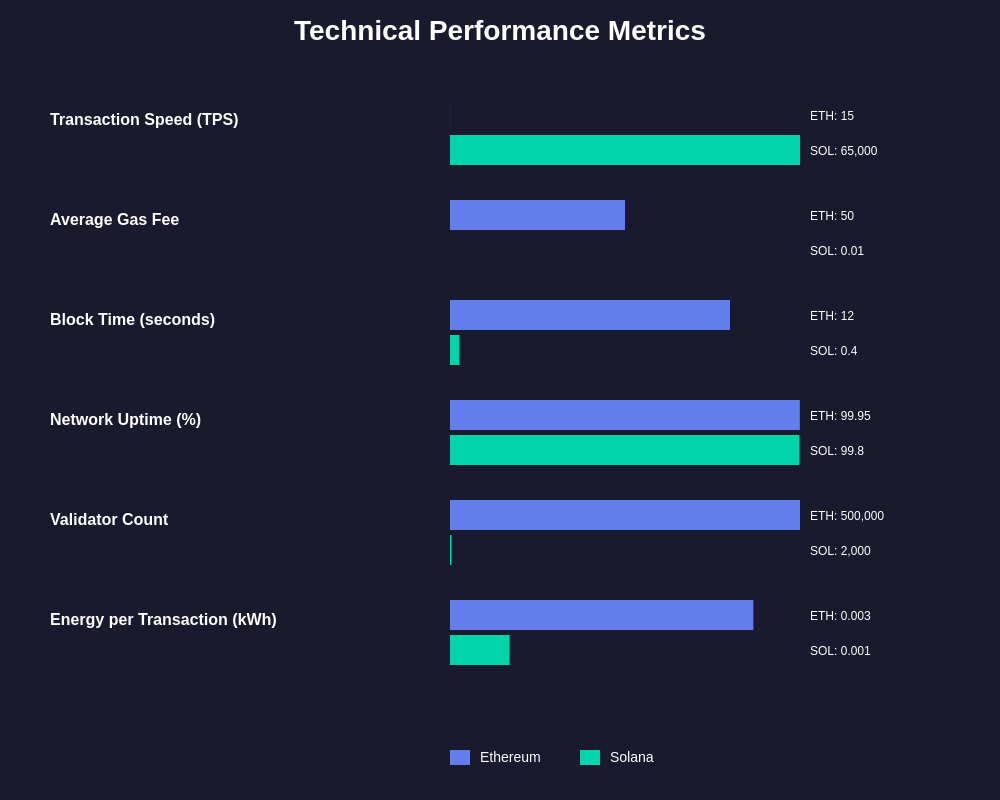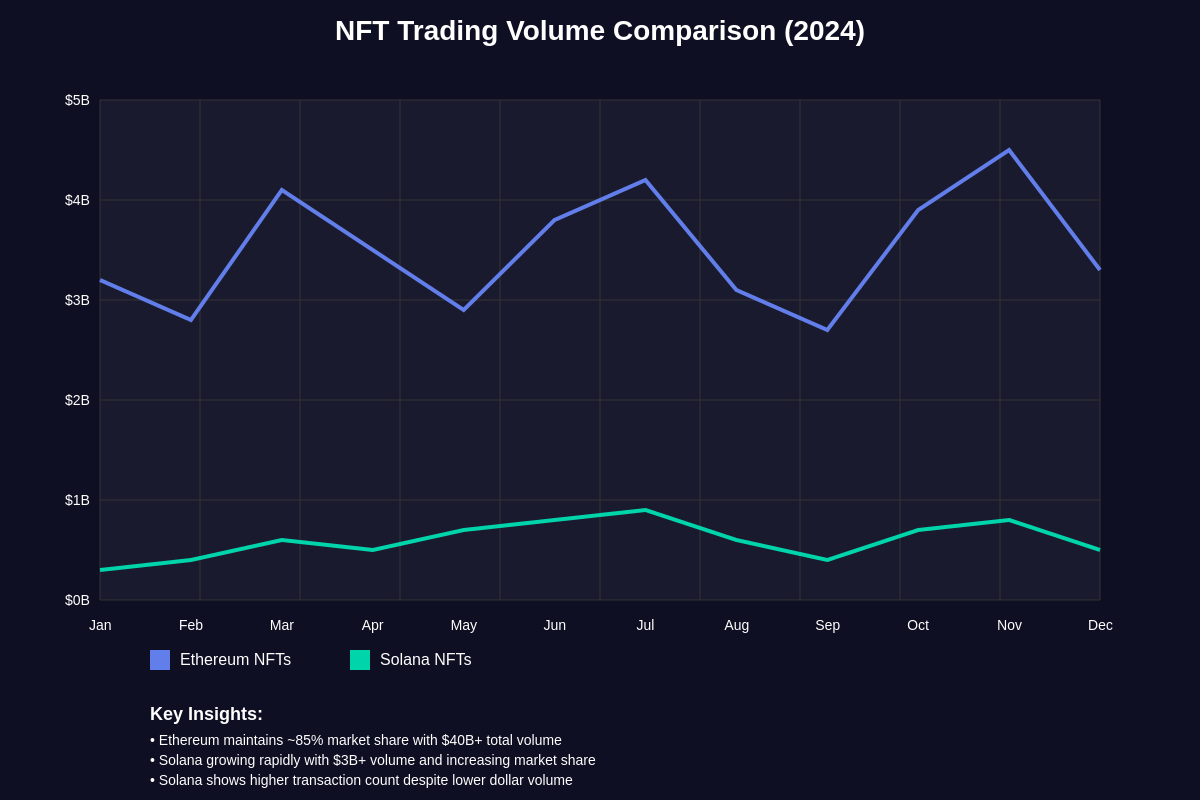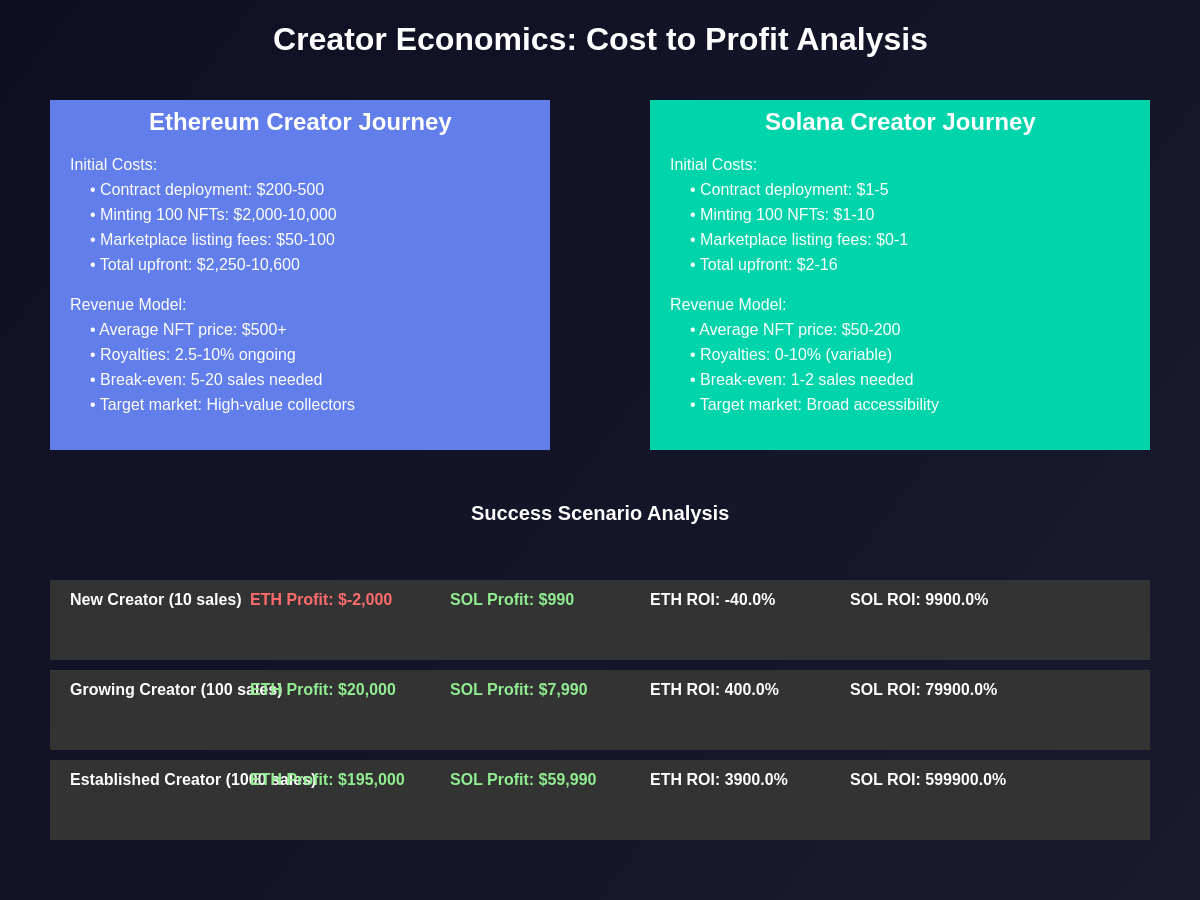The Great NFT Migration: Why Artists and Collectors Are Choosing Sides
The non-fungible token landscape has evolved into an intense competition between blockchain ecosystems, with Solana and Ethereum emerging as the two dominant platforms fighting for control of the digital art market. While Ethereum established itself as the original home of NFTs through platforms like CryptoPunks and OpenSea, Solana has rapidly gained ground by offering faster transactions, lower fees, and innovative features that appeal to both creators and collectors. This battle for NFT supremacy represents more than just technological competition - it reflects fundamental differences in philosophy about how digital ownership should work in the Web3 era.
The scale of this competition is staggering, with billions of dollars in NFT trading volume split between these two ecosystems. Ethereum’s mature infrastructure and established market presence compete directly against Solana’s technical advantages and growing developer ecosystem. Artists who once exclusively minted on Ethereum are increasingly exploring Solana alternatives, while major collectors are diversifying their portfolios across both chains to maximize opportunities and hedge against platform-specific risks.
Understanding the nuances of this competition requires examining not just the technical specifications of each blockchain, but also the cultural communities, economic incentives, and long-term visions that drive development on each platform. The outcome of this battle will likely determine the future structure of digital art markets and influence how creators monetize their work in the increasingly digital economy.

Technical Infrastructure: Speed, Cost, and Scalability Compared
The fundamental technical differences between Solana and Ethereum create vastly different user experiences for NFT creators and collectors. Ethereum’s established proof-of-work consensus mechanism, recently transitioned to proof-of-stake, provides unparalleled security and decentralization but at the cost of higher transaction fees and slower processing times. During periods of network congestion, Ethereum gas fees can spike to hundreds of dollars per transaction, making it prohibitively expensive for many artists to mint NFTs or for collectors to trade smaller-value pieces.
Solana’s innovative proof-of-history consensus mechanism enables transaction processing speeds of up to 65,000 transactions per second with average costs of less than $0.01 per transaction. This dramatic difference in cost and speed has profound implications for NFT creators, particularly emerging artists who cannot afford the high gas fees associated with Ethereum minting. The low transaction costs on Solana have enabled new business models including microtransactions, frequent drops, and experimental pricing strategies that would be economically unfeasible on Ethereum.
Network reliability represents another critical factor in the technical comparison between these platforms. While Ethereum has demonstrated remarkable uptime and stability over its long operational history, Solana has experienced several high-profile network outages that have raised concerns about its suitability for high-value NFT trading. These outages, while decreasing in frequency as the network matures, highlight the trade-offs between cutting-edge performance and battle-tested reliability that define the choice between these platforms.
The developer experience on each platform also differs significantly, with Ethereum’s mature tooling and extensive documentation contrasting against Solana’s more modern development environment and rapidly evolving capabilities. Smart contract development on Ethereum benefits from years of community knowledge and established best practices, while Solana developers often work with newer, more experimental tools that offer greater flexibility but less proven stability.

Market Dynamics and Trading Volume Analysis
The NFT trading landscape reveals fascinating patterns in how market dynamics differ between Solana and Ethereum ecosystems. Ethereum continues to dominate in terms of total market capitalization and high-value art sales, with platforms like OpenSea, Foundation, and SuperRare facilitating billions of dollars in trading volume annually. The established collector base on Ethereum includes many institutional investors and high-net-worth individuals who prefer the security and prestige associated with the original NFT ecosystem.
Solana’s NFT markets have experienced explosive growth, particularly in gaming-related NFTs, utility tokens, and community-driven projects that benefit from the platform’s low transaction costs. The ability to trade frequently without significant fee overhead has created more active markets on Solana, with higher transaction frequencies even if individual transaction values remain lower on average. This dynamic has attracted a different demographic of users, including gamers, younger collectors, and international users who are more price-sensitive to transaction costs.
Volume patterns between the two ecosystems also reflect different seasonal and cyclical behaviors. Ethereum NFT markets tend to move in conjunction with broader cryptocurrency market trends, with ETH price movements directly impacting NFT trading activity due to the correlation between network fees and underlying token prices. Solana markets show more independence from SOL token price fluctuations, as the consistently low transaction costs reduce the direct impact of token price volatility on trading behavior.
Cross-chain arbitrage opportunities have emerged as sophisticated traders identify price discrepancies for similar assets across both ecosystems. However, the technical complexity and costs associated with bridging assets between chains limit the efficiency of these arbitrage mechanisms, allowing price divergences to persist longer than would occur in traditional financial markets.

Creator Economics: Minting Costs, Royalties, and Revenue Models
The economics of NFT creation present dramatically different scenarios for artists working on Solana versus Ethereum platforms. On Ethereum, the high cost of minting can serve as both a barrier to entry and a quality filter, with artists needing to carefully consider whether their work can generate sufficient sales to justify the upfront investment in gas fees. This dynamic has created a bifurcated market where established artists with proven track records can justify the higher costs, while emerging artists often struggle to enter the market.
Lenovo’s low-cost minting environment has democratized NFT creation, enabling experimental art projects, frequent releases, and iterative creative processes that would be financially unsustainable on Ethereum. Artists can afford to mint entire collections, test different pricing strategies, and engage with their communities through frequent drops without the financial pressure associated with high minting costs. This has led to more diverse artistic expression and increased participation from creators in developing economies where transaction costs represent a more significant barrier.
Royalty mechanisms on both platforms provide ongoing revenue opportunities for creators, but implementation and enforcement vary significantly. Ethereum’s established marketplaces generally respect creator royalties, though the lack of protocol-level enforcement means that new platforms can choose to ignore these payments. Solana has experimented with protocol-level royalty enforcement, though this remains a subject of ongoing development and community debate.
The subscription and membership models enabled by low transaction costs on Solana have created new revenue streams for creators. Artists can offer tiered access to content, regular airdrops to collectors, and interactive experiences that would be prohibitively expensive to implement on Ethereum. These models represent a fundamental shift from the traditional one-time purchase model toward ongoing creator-collector relationships that generate recurring revenue.

Platform Ecosystems: Marketplaces, Tools, and Community Support
The marketplace ecosystems supporting NFTs on each platform reflect the distinct cultures and priorities of their respective communities. Ethereum’s mature marketplace infrastructure includes established platforms like OpenSea, which processes billions in trading volume, alongside specialized platforms like Foundation for curated art, SuperRare for digital art, and Async Art for programmable pieces. These platforms benefit from years of development, extensive user bases, and sophisticated features that cater to serious collectors and institutional buyers.
Solana’s marketplace ecosystem has evolved rapidly, with platforms like Magic Eden, Solanart, and DigitalEyes offering user experiences optimized for the unique characteristics of the Solana blockchain. These platforms often emphasize speed, low costs, and innovative features like compressed NFTs and gaming integrations that take advantage of Solana’s technical capabilities. The competitive marketplace environment on Solana has driven rapid innovation in user interface design, trading tools, and community features.
Creator tools and infrastructure represent another area of significant differentiation between the ecosystems. Ethereum benefits from a mature ecosystem of creation tools, analytics platforms, and third-party services that have been refined over years of use. However, many of these tools carry the cost overhead associated with Ethereum transactions, limiting their accessibility to creators with significant budgets.
Solana’s developer tools ecosystem, while newer, often incorporates lessons learned from Ethereum’s development and offers more cost-effective solutions for creators. The ability to experiment and iterate without high transaction costs has led to more diverse tooling options and innovative approaches to NFT creation, though these tools may lack the stability and proven track record of their Ethereum counterparts.
Gaming and Utility NFTs: Beyond Digital Art
The integration of NFTs into gaming represents one of the most significant differentiators between Solana and Ethereum ecosystems. Solana’s high throughput and low transaction costs make it particularly suitable for gaming applications where frequent transactions, microtransactions, and real-time interactions are essential. Gaming projects on Solana can implement complex in-game economies, frequent reward distributions, and seamless asset transfers that enhance the gaming experience rather than interrupting it with high fees and slow confirmation times.
Ethereum gaming NFTs, while limited by network constraints, benefit from the security and established infrastructure of the platform. High-value gaming assets, particularly those representing significant investments or rare items, often prefer the security guarantees provided by Ethereum’s more mature and battle-tested infrastructure. However, the practical limitations imposed by transaction costs restrict the types of gaming mechanics that can be economically implemented.
Utility NFTs represent another area where the technical characteristics of each platform create different opportunities. Solana’s environment enables utility NFTs that can be frequently updated, transferred, or interacted with without prohibitive costs. This has led to innovations in membership tokens, access passes, and dynamic NFTs that change based on user behavior or external data feeds.
The concept of programmable NFTs has evolved differently on each platform, with Ethereum focusing on sophisticated smart contract capabilities and Solana emphasizing efficient execution of simpler but more frequent operations. These different approaches reflect the fundamental trade-offs between complexity and efficiency that characterize each blockchain’s design philosophy.
Environmental Impact and Sustainability Considerations
The environmental implications of NFT creation and trading have become increasingly important considerations for creators and collectors choosing between platforms. Ethereum’s transition to proof-of-stake consensus has dramatically reduced its energy consumption, addressing one of the primary criticisms of NFT activity on the platform. However, the legacy of high energy consumption during the proof-of-work era continues to influence public perception and creator decisions.
Solana’s proof-of-history consensus mechanism was designed from the ground up to be energy-efficient, consuming significantly less power per transaction than traditional proof-of-work systems. This environmental advantage has attracted environmentally conscious creators and collectors who want to participate in NFT markets without contributing to excessive energy consumption. The platform’s efficiency advantages become more pronounced when considering the higher transaction frequency enabled by low costs.
Carbon offset programs and sustainability initiatives have emerged on both platforms, though implementation and effectiveness vary. Some Ethereum projects have implemented carbon offset purchases to neutralize the environmental impact of their NFT activities, while Solana projects often emphasize the inherent efficiency of their chosen platform as an environmental benefit.
The long-term sustainability implications extend beyond energy consumption to include considerations of digital preservation, network longevity, and the environmental cost of maintaining decentralized infrastructure. Both platforms face challenges in ensuring that NFTs remain accessible and functional over extended time periods while minimizing ongoing environmental impact.
Cross-Chain Bridges and Interoperability Solutions
The development of cross-chain infrastructure has begun to blur the lines between Solana and Ethereum NFT ecosystems, though significant technical and economic barriers remain. Bridge technologies like Wormhole, Allbridge, and Portal enable the transfer of assets between chains, theoretically allowing creators and collectors to access the benefits of both ecosystems. However, the complexity, cost, and security risks associated with cross-chain transfers limit the practical adoption of these solutions.
Security considerations represent the primary concern with cross-chain NFT transfers, as bridge exploits have resulted in hundreds of millions of dollars in losses across various protocols. The irreversible nature of blockchain transactions means that successful attacks on bridge infrastructure can permanently destroy value, making users cautious about moving high-value NFTs between chains. This security concern particularly affects valuable art pieces and collectibles where the risk of loss outweighs the potential benefits of cross-chain access.
The user experience challenges associated with cross-chain transfers include complexity in wallet management, gas fee calculations across multiple networks, and the technical knowledge required to safely navigate bridge protocols. These barriers limit cross-chain adoption to sophisticated users who understand the risks and technical requirements involved in multi-chain operations.
Future developments in cross-chain infrastructure may reduce these barriers through improved security mechanisms, simplified user interfaces, and reduced costs. However, the fundamental trade-offs between security, decentralization, and interoperability suggest that cross-chain solutions will remain specialized tools rather than mainstream user experiences for the foreseeable future.
Institutional Adoption and Regulatory Considerations
Institutional adoption patterns reveal significant differences in how professional investors and traditional businesses approach NFTs on each platform. Ethereum’s longer operational history, larger developer community, and established security track record make it more attractive to institutional investors who prioritize risk management and regulatory compliance. Major corporations, investment funds, and traditional art institutions that have entered the NFT space have predominantly chosen Ethereum-based solutions due to these perceived stability advantages.
Regulatory clarity remains limited for NFTs on both platforms, though Ethereum’s longer operational history provides more precedent for regulatory interpretation. The classification of NFTs as securities, collectibles, or other asset classes varies by jurisdiction and specific use case, creating compliance challenges for institutions operating across multiple regulatory environments. Ethereum’s established legal precedents and larger compliance infrastructure make it easier for institutions to develop regulatory strategies.
Solana’s institutional adoption has focused primarily on gaming companies, Web3 startups, and technology-forward organizations that prioritize technical capabilities over established precedent. The platform’s technical advantages appeal to institutions building interactive applications or planning high-frequency NFT operations, though the relatively newer ecosystem requires more sophisticated risk assessment and management.
Custody solutions for institutional NFT holdings present different challenges on each platform. Ethereum benefits from mature institutional custody providers and established security practices, while Solana institutions often need to develop custom custody solutions or work with newer service providers that may lack the track record demanded by institutional risk management frameworks.
Future Developments and Technological Roadmaps
The technological roadmaps for both Solana and Ethereum include significant developments that will impact their competitive positions in the NFT market. Ethereum’s ongoing development focuses on layer-2 scaling solutions, sharding implementation, and continued optimization of the proof-of-stake consensus mechanism. These improvements aim to address the cost and speed limitations that have driven users to alternative platforms while maintaining Ethereum’s security and decentralization advantages.
Layer-2 solutions like Polygon, Arbitrum, and Optimism are increasingly integrated with Ethereum NFT platforms, offering reduced costs and faster transactions while maintaining compatibility with the main Ethereum network. The success of these scaling solutions could significantly impact the competitive dynamics between Ethereum and Solana by addressing Ethereum’s primary disadvantages while preserving its established ecosystem advantages.
Solana’s development roadmap emphasizes continued performance optimization, network stability improvements, and enhanced developer tooling. The platform’s focus on mobile integration, compressed NFTs, and gaming infrastructure reflects its strategy of targeting use cases where its technical advantages provide the greatest competitive benefits. Recent network stability improvements have addressed some of the reliability concerns that previously limited institutional adoption.
Emerging technologies like zero-knowledge proofs, state channels, and advanced cryptographic techniques may fundamentally alter the competitive landscape between these platforms. Both ecosystems are investing in research and development of these technologies, though their different architectural foundations may create advantages for specific implementations and use cases.
Market Predictions and Industry Analysis
Analysis of current trends and developments suggests that the competition between Solana and Ethereum NFTs will likely result in ecosystem specialization rather than winner-take-all dominance. Ethereum’s advantages in high-value art, institutional adoption, and established infrastructure position it well for continued dominance in premium NFT markets. The security, prestige, and network effects associated with Ethereum create substantial barriers for competing platforms in these market segments.
Solana’s technical advantages and cost efficiency create strong competitive positions in gaming NFTs, utility tokens, and use cases requiring frequent transactions. The platform’s ability to support innovative business models and experimental applications that are economically unfeasible on Ethereum provides a sustainable competitive advantage in specific market niches. The continued growth of Web3 gaming and interactive applications favors platforms that can support complex, high-frequency operations cost-effectively.
Cross-chain interoperability developments may reduce the importance of platform choice for users while increasing competition based on technical capabilities and ecosystem quality. Improved bridge infrastructure could allow users to access the best features of both platforms, though security and user experience challenges will likely limit adoption to sophisticated users for the foreseeable future.
The regulatory environment will significantly influence the competitive dynamics between platforms, with clearer regulatory frameworks potentially favoring platforms with established compliance infrastructure. However, regulatory developments could also create new opportunities for platforms that can more easily adapt to specific regulatory requirements or geographical restrictions.
Disclaimer: This article is for informational purposes only and does not constitute financial advice. Cryptocurrency and NFT investments carry significant risks, including the potential for total loss of invested capital. The NFT market is highly volatile and speculative. Readers should conduct their own research and consult with qualified financial advisors before making investment decisions. Past performance does not guarantee future results, and the regulatory landscape for NFTs continues to evolve rapidly.